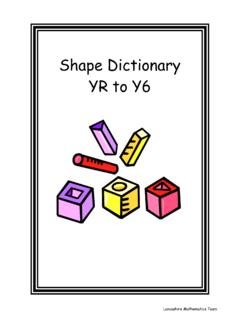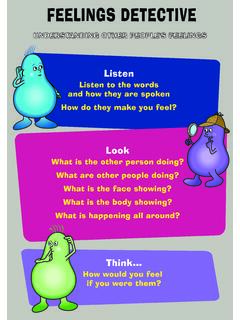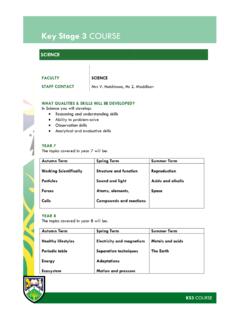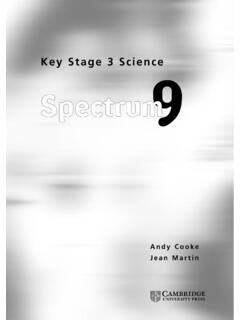Transcription of SCIENCE - KEY STAGE 3 - lancsngfl.ac.uk
1 SCIENCE Programme of study for Key STAGE 3 February 2013 2 Contents Purpose of study 3 Aims 3 Attainment targets 3 Working scientifically 4 Subject content 6 Biology 6 Structure and function of living organisms 6 Energy flow and material cycles 7 Interactions and interdependencies 7 Genetics and evolution 8 Chemistry 9 Physics 11 Energy 11 Motion and forces 11 Waves 12 Electricity and electromagnetism 13 Matter 14 3 Purpose of study A high-quality SCIENCE education provides the foundations for understanding the world through the specific disciplines of biology, chemistry and physics. SCIENCE has changed our lives and is vital to the world s future prosperity, and all pupils should be taught essential aspects of the knowledge, methods, processes and uses of SCIENCE . Through building up a body of key foundational knowledge and concepts, pupils should be encouraged to recognise the power of rational explanation and develop a sense of excitement and curiosity about natural phenomena.
2 They should be encouraged to understand how key foundational knowledge and concepts can be used to explain what is occurring, predict how things will behave, and analyse causes. This foundational understanding should be consolidated through their appreciation of the specific applications of SCIENCE in society and the economy. Aims The National Curriculum for SCIENCE aims to ensure that all pupils: develop scientific knowledge and conceptual understanding through the specific disciplines of biology, chemistry and physics develop understanding of the nature, processes and methods of SCIENCE through different types of SCIENCE enquiries that help them to answer scientific questions about the world around them are equipped with the scientific knowledge required to understand the uses and implications of SCIENCE , today and for the future.
3 Attainment targets By the end of each key STAGE , pupils are expected to know, apply and understand the matters, skills and processes specified in the relevant programme of study. 4 Working scientifically Through the content across all three disciplines, pupils should be taught to: Experimental skills and investigations ask questions and develop a line of enquiry based on observations of the real world, alongside prior knowledge and experience make predictions using scientific knowledge and understanding plan and design investigations and experiments to make observations and to test predictions, including identifying independent, dependent and control variables and their intrinsic nature and other factors to be taken into account when collecting evidence and data use appropriate techniques, apparatus, and materials during fieldwork and laboratory work, paying attention to health and safety make and record observations and measurements using a range of methods for different investigations.
4 And evaluate the reliability of methods and suggest possible improvements Handling information and problem solving present observations and data using appropriate methods, including tables and graphs interpret observations and data, including identifying patterns and using observations, measurements and data to draw conclusions present reasoned explanations, including explaining data in relation to predictions and hypotheses evaluate data, showing awareness of potential sources of random and systematic error identify further questions arising from their results Scientific attitudes pay attention to objectivity and concern for validity, accuracy, precision and measurement of uncertainty understand that scientific methods and theories develop as scientists modify earlier explanations to take account of new evidence and ideas, together with the importance of publishing results and peer review evaluate risks 5 Measurement understand and use SI units and IUPAC (International Union of Pure and Applied Chemistry) chemical nomenclature use and derive simple equations undertake basic data analysis.
5 6 Subject content Biology Structure and function of living organisms Pupils should be taught about: Cells and organisation cells as the fundamental unit of living organisms, including how to observe and record cell structure using a light microscope the functions of the cell wall, cell membrane, cytoplasm, nucleus, vacuole, mitochondria and chloroplasts the similarities and differences between plant and animal cells the role of diffusion in the movement of materials in and between cells the structure of Amoeba and Euglena the hierarchical organisation of multicellular organisms: from cells to tissues to organs to systems to organisms The skeletal and muscular systems the structure and functions of the human skeleton, to include support, protection, movement and making blood cells biomechanics the interaction between skeleton and muscles, including the measurement of force exerted by different muscles the function and antagonistic actions of major muscle groups Human nutrition and digestion content in a healthy human diet.
6 Carbohydrates, fats, proteins, vitamins, minerals, dietary fibre and water, and why each is needed simple food tests for starch, simple (reducing) sugars, protein, fat calculations of energy requirements in a healthy daily diet the consequences of imbalances in the diet, including obesity, starvation and deficiency diseases the tissues and organs of the digestive system, including adaptations to function and how the digestive system digests food (enzymes simply as biological catalysts) the importance of bacteria in the digestive system 7 The breathing (gas exchange) system the structure and functions of the gas exchange system in humans, including adaptations to function the mechanism of breathing to move air in and out of the lungs, using a pressure model to explain the movement of gases, including simple measurements of lung volume the impact of exercise, asthma and smoking on the breathing system Health the effects of drugs (including as medicines as well as substance misuse) on behaviour, health and life processes such as conception, growth and development.
7 Energy flow and material cycles Pupils should be taught about: Photosynthesis the dependence of almost all life on Earth on the transfer of solar energy to plants and algae in photosynthesis the relationship between the structures and functions of leaves, including chloroplasts and stomata reactants in, and products of, photosynthesis, and the word equation for photosynthesis mineral nutrition in plants, to explain the role of nitrates chemosynthesis in bacteria and other organisms Cellular respiration aerobic and anaerobic respiration in living organisms, including the breakdown of organic molecules to enable all the other chemical processes necessary for life the word equation for aerobic respiration the process of anaerobic respiration in humans and micro-organisms, including fermentation.
8 And the word equation for anaerobic respiration the differences between aerobic and anaerobic respiration. Interactions and interdependencies Pupils should be taught about: Relationships in an ecosystem the interdependence of organisms, including food webs and the accumulation of toxic materials 8 how organisms affect, and are affected by, their environment niches and the role of variation in enabling closely-related living things to survive in the same ecosystem. Genetics and evolution Pupils should be taught about: Reproduction reproduction in humans (as an example of a mammal), including the structure and function of the male and female reproductive systems, menstrual cycle (without details of hormones), gametes, fertilisation, gestation and birth, to include the effect of maternal lifestyle on the foetus through the placenta reproduction in plants, including flower structure, wind and insect pollination, fertilisation, seed and fruit formation and dispersal, including quantitative investigation of some dispersal mechanisms the importance of plant reproduction through insect pollination in human food security Inheritance, chromosomes, DNA and genes heredity as the process by which genetic information is transmitted from one generation to the next a simple model of chromosomes, genes and DNA in heredity, including the part played by Watson, Crick.
9 Wilkins and Franklin in the development of the DNA model the variation between individuals of different species the variation between individuals within a species being continuous or discontinuous, to include measurement and graphical representation of variation the variation between species and between individuals of the same species leading to competition which can drive adaptation changes in the environment that leave some species less well adapted to compete successfully and reproduce, which might lead to extinction the use of gene banks to preserve hereditary material before a species becomes extinct. 9 Chemistry Pupils should be taught about: Pure and impure substances mixtures, including dissolving techniques for separating mixtures: chromatography, filtering, evaporation and distillation the identification of pure substances The particulate nature of matter the properties of the different states of matter (solid, liquid and gas)
10 In terms of particle kinetics, including gas pressure and diffusion changes of state in terms of particle kinetics and energy changes Atoms, elements and compounds the nature of atoms, elements and compounds chemical symbols and formulae for elements and compounds conservation of mass in chemical and physical change Chemical reactions chemical reactions as the rearrangement of atoms representing chemical reactions using formulae and using equations, including state symbols combustion, thermal decomposition, oxidation and displacement reactions Energetics exothermic and endothermic chemical reactions (qualitative) Acids, alkalis and neutralisation defining acids, bases and alkalis in terms of neutralisation reactions the pH scale for measuring acidity/alkalinity; and indicators reactions of acids with bases and metals to produce a salt, plus water The Periodic Table the Periodic Table: periods and groups.












